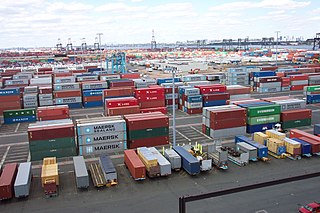
Containerization is a system of intermodal freight transport using intermodal containers. Containerization, also referred as container stuffing or container loading, is the process of unitization of cargoes in exports. Containerization is the predominant form of unitization of export cargoes, as opposed to other systems such as the barge system or palletization. The containers have standardized dimensions. They can be loaded and unloaded, stacked, transported efficiently over long distances, and transferred from one mode of transport to another—container ships, rail transport flatcars, and semi-trailer trucks—without being opened. The handling system is completely mechanized so that all handling is done with cranes and special forklift trucks. All containers are numbered and tracked using computerized systems.

A railroad car, railcar, railway wagon, railway carriage, railway truck, railwagon, railcarriage or railtruck, also called a train car, train wagon, train carriage or train truck, is a vehicle used for the carrying of cargo or passengers on a rail transport network. Such cars, when coupled together and hauled by one or more locomotives, form a train. Alternatively, some passenger cars are self-propelled in which case they may be either single railcars or make up multiple units.
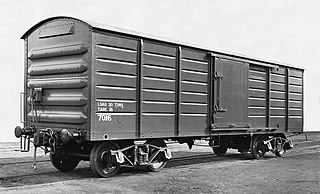
A boxcar is the North American (AAR) term for a railroad car that is enclosed and generally used to carry freight. The boxcar, while not the simplest freight car design, is considered one of the most versatile since it can carry most loads. Boxcars have side sliding doors of varying size and operation, and some include end doors and adjustable bulkheads to load very large items.
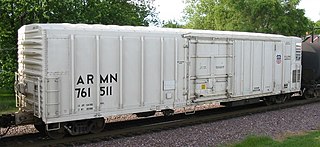
A refrigerator car is a refrigerated boxcar (U.S.), a piece of railroad rolling stock designed to carry perishable freight at specific temperatures. Refrigerator cars differ from simple insulated boxcars and ventilated boxcars, neither of which are fitted with cooling apparatus. Reefers can be ice-cooled, come equipped with any one of a variety of mechanical refrigeration systems, or utilize carbon dioxide as a cooling agent. Milk cars may or may not include a cooling system, but are equipped with high-speed trucks and other modifications that allow them to travel with passenger trains.

An autorack, also known as an auto carrier, is a specialized piece of railroad rolling stock used to transport automobiles and light trucks. Autoracks are used to transport new vehicles from factories to automotive distributors, and to transport passengers' vehicles in car shuttles and motorail services, such as Amtrak's Auto Train route.

A siding, in rail terminology, is a low-speed track section distinct from a running line or through route such as a main line, branch line, or spur. It may connect to through track or to other sidings at either end. Sidings often have lighter rails, meant for lower speed or less heavy traffic, and few, if any, signals. Sidings connected at both ends to a running line are commonly known as loops; those not so connected may be referred to as single-ended or dead-end sidings, or stubs.

A rail yard, railway yard, railroad yard (US) or simply yard, is a series of tracks in a rail network for storing, sorting, or loading and unloading rail vehicles and locomotives. Yards have many tracks in parallel for keeping rolling stock or unused locomotives stored off the main line, so that they do not obstruct the flow of traffic. Cars or wagons are moved around by specially designed yard switcher locomotives (US) or shunter locomotives (UK), a type of locomotive. Cars or wagons in a yard may be sorted by numerous categories, including railway company, loaded or unloaded, destination, car type, or whether they need repairs. Yards are normally built where there is a need to store rail vehicles while they are not being loaded or unloaded, or are waiting to be assembled into trains. Large yards may have a tower to control operations.
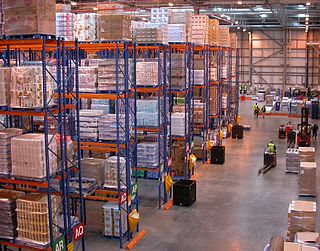
A distribution center for a set of products is a warehouse or other specialized building, often with refrigeration or air conditioning, which is stocked with products (goods) to be redistributed to retailers, to wholesalers, or directly to consumers. A distribution center is a principal part, the order processing element, of the entire order fulfillment process. Distribution centers are usually thought of as being demand driven. A distribution center can also be called a warehouse, a DC, a fulfillment center, a cross-dock facility, a bulk break center, and a package handling center. The name by which the distribution center is known is commonly based on the purpose of the operation. For example, a "retail distribution center" normally distributes goods to retail stores, an "order fulfillment center" commonly distributes goods directly to consumers, and a cross-dock facility stores little or no product but distributes goods to other destinations.

The Wiscasset, Waterville and Farmington Railway is a 2 ft narrow gauge railway. The line was operated as a for-profit company from 1895 until 1933 between the Maine towns of Wiscasset, Albion, and Winslow, but was abandoned in 1936. Today, about three miles (4.8 km) of the track in the town of Alna has been rebuilt and is operated by the non-profit Wiscasset, Waterville and Farmington Railway Museum as a heritage railroad offering passenger excursion trains and hauling occasional cargo.
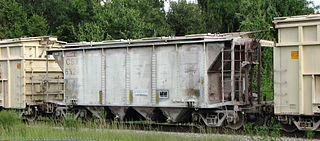
A covered hopper is a self-clearing, enclosed, weatherproof railroad freight car. It has a fixed roof, sides, and ends with openings for loading through the top and unloading through the bottom. Covered hopper cars are designed for carrying dry bulk loads, such as grain, sand, clay and Portland cement.

A rotary car dumper or wagon tippler (UK) is a mechanism used for unloading certain railroad cars such as hopper cars, gondolas or mine cars. It holds the rail car to a section of track and then rotates the track and car together to dump out the contents. Used with gondola cars, it is making open hopper cars obsolete. Because hopper cars require sloped chutes in order to direct the contents to the bottom dump doors (hatches) for unloading, gondola cars allow cars to be lower, thus lowering their center of gravity, while carrying the same gross rail load. Cars are equipped with rotary couplers to allow dumping them while they are still coupled; a "Double Rotary" gondola or hopper is has rotary couplers on both ends to allow it to be unloaded while it remains coupled to stationary cars at each end.

Rail freight transport is the use of railroads and trains to transport cargo as opposed to human passengers.

A silo is a structure for storing bulk materials. Silos are used in agriculture to store fermented feed known as silage, not to be confused with a grain bin, which is used to store grains. Silos are commonly used for bulk storage of grain, coal, cement, carbon black, woodchips, food products and sawdust. Three types of silos are in widespread use today: tower silos, bunker silos, and bag silos.

A goods shed is a railway building designed for storing goods before, after, and during loading to and unloading from a train. A typical goods shed will have a track running through it to allow goods wagons to be unloaded under cover, although sometimes they were built alongside a track with possibly just a canopy over the door. There will also be a door to move goods to or from road wagons and vans, this sometimes is parallel to the rail track, or sometimes on the side opposite the rail track. Inside the shed will generally be a platform and sometimes a small crane to allow easier loading and unloading of wagons.

A RIP track, short for repair in place track, is a designated track, or tracks, in a rail yard or a siding along a section of a main rail line where locomotives and/or railroad cars can be placed for minor repairs. A RIP track allows for minor repairs to be done without removing the units from service and sometimes allows for these repairs to be done without removing a freight load from the car. In some yards, a RIP track may be used for staging locomotives or damaged cars for major repairs and some rail yards may have more than one RIP track to serve both functions.
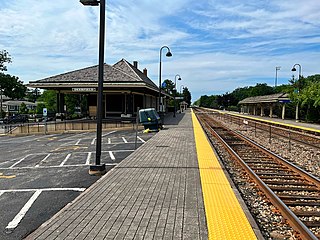
Deerfield is one of two Metra commuter railroad stations in Deerfield, Illinois along the Milwaukee District North Line. It is located at 860 Deerfield Road, 2 blocks west of Illinois State Route 43, is 24.6 miles (39.6 km) away from Chicago Union Station, the southern terminus of the line. The station serves commuters between Union Station and Fox Lake, Illinois. As of 2018, Deerfield is the 39th busiest of Metra's 236 non-downtown stations, with an average of 1,133 weekday boardings. The current station originally served the Chicago, Milwaukee, St. Paul & Pacific Railroad, and replaced two older stations built by the railway.

Waukegan is a railroad station in Waukegan, Illinois, served by Metra's Union Pacific North Line. It is officially located on 95 North Spring Street, is 36.0 miles (57.9 km) away from Ogilvie Transportation Center, the inbound terminus of the Union Pacific North Line, and also serves commuters who travel north to Kenosha, Wisconsin. In Metra's zone-based fare system, Waukegan is in zone H. As of 2018, Waukegan is the 67th busiest of Metra's 236 non-downtown stations, with an average of 764 weekday boardings.

Goods wagons or freight wagons, also known as goods carriages, goods trucks, freight carriages or freight trucks, are unpowered railway vehicles that are used for the transportation of cargo. A variety of wagon types are in use to handle different types of goods, but all goods wagons in a regional network typically have standardized couplers and other fittings, such as hoses for air brakes, allowing different wagon types to be assembled into trains. For tracking and identification purposes, goods wagons are generally assigned a unique identifier, typically a UIC wagon number, or in North America, a company reporting mark plus a company specific serial number.
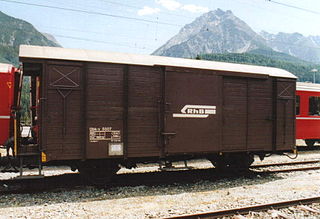
A covered goods wagon or van is a railway goods wagon which is designed for the transportation of moisture-susceptible goods and therefore fully enclosed by sides and a fixed roof. They are often referred to simply as covered wagons, and this is the term used by the International Union of Railways (UIC). Since the introduction of the international classification for goods wagons by the UIC in the 1960s a distinction has been drawn between ordinary and special covered wagons. Other types of wagon, such as refrigerated vans and goods wagons with opening roofs, are closely related to covered wagons from a design point of view. Similar freight cars in North America are called boxcars.
The Victorian Railways used a variety of flat wagons for the transport of a wide range of loads. Generally speaking, the bogie wagons were custom-built for the job, while the fixed-wheel variants were cut down from former open wagons. Loadings would be placed on the deck and, if necessary, protected with tarps, then secured to the wagons with chains or rope connecting to lashing rings along the side of the wagon frames.























